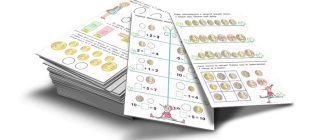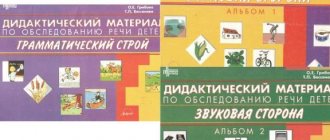Economic education of preschoolers
Moral and labor education
There is no pure economy in the preschool period, but there are prerequisites for the economic education of a child.
You can give accessible knowledge, introduce frugality, economy, rationality, efficiency. Economics
is the art and rule of housekeeping.
This definition is suitable for preschool education.
A child is brought up only through activity. When it comes to economic culture, activity must be labor. Labor is the most important category of economic thinking; it is relevant in any form of society. Finance, money, price, value are only components of this category.
The author of the course “The Path to Economics” of the Russian Textbook Corporation emphasizes that the formation of financial literacy in preschoolers must be built into the system of moral and labor education. The goal of the course is the economic socialization of children. Children learn from an early age to appreciate what adults create for them and for a happy life. This is an important skill of a harmonious socialized personality.
Me and the world around. Allowance for children 5-6 years old
This manual is included in the teaching materials “Steps to school” and is intended for developmental activities with children 5-6 years old. The proposed variants of tasks in the manuals of the series assume the active involvement of the child in cognitive activity, taking into account his strong and weak sides of development, and the possibility of taking into account individual characteristics with the help and help of adults. The manual “Me and the World Around” includes tasks that will help the child better know himself, the world around him and understand his place in it. Complies with the Federal State Educational Standard for Preschool Education (2014).
Buy
FAQ
At what age is a child ready to learn economic fundamentals?
As a rule, from the age of five. The level of readiness of children varies. However, as practice shows, in older preschool groups children already understand such concepts as price and benefit.
How to implement an economic literacy program?
It is possible both in separate training blocks and as part of regular classes. It is best to combine: dedicate time twice a week for the purposeful formation of an economic understanding in children, and also daily introduce certain techniques into standard educational situations.
What is financial literacy?
Financial literacy is the knowledge, skills and abilities that a person needs to make smart financial decisions, as well as to achieve financial well-being.
A financially literate person is a person who:
- knows how to competently handle funds, preserve and increase them;
- keeps records of income and expenses;
- navigates the economic situation of the country;
- can recognize signs of financial fraud;
- fulfills its obligations as a taxpayer;
- knows how to navigate banking services.
For a long time, it was believed that financial literacy was necessary only for employees of financial institutions. But a 2017 survey by the National Financial Research Agency found that people are increasingly complaining about a lack of economic and financial knowledge that would help them, for example, avoid taking part in dubious financial transactions. And only 12% of respondents believe that they have a sufficient level of financial awareness.
Therefore, our country is now actively pursuing a policy to increase financial literacy among the adult population and the younger generation. Special literature is published for children, and economic games and applications are created. Information sites and online courses on personal finance management are intended for adults.
Useful materials for children and parents
10 Best Financial Literacy Books for Children of All Ages:
- Evgenia Bliskavka. Children and money.
- Bodo Schaefer. A dog named Mani.
- Igor Lipsits. Amazing adventures in the country of Economics.
- Anna Voronina. Mathematics and money: buy, sell, exchange.
- Tatiana Popova, Anastasia Bulavkina. Magic ATM.
- Elena Uleva. Where does the money come from? Encyclopedia for kids.
- Heidley Fidler. Instructions for money. An amazingly fun guide to the world of finance.
- Sergey Bidenko, Irina Zolotarevich. I want to earn money. Useful tips for children and teenagers +60 ideas for making money.
- Sergey Bidenko, Irina Zolotarevich. Financial stories for teenagers.
- Jerry Bailey, Felicia Law. Your money.
5 best online games:
- “The path to financial success”, (game from Volgograd State University) https://pfu.volsu.ru/index.php/site/index
- Financial game Portfolio https://fgramota.org/game/
- Finnznaika https://finznaika.rf/site/abilities-kids
- Monetkiny https://monetkiny.rf/
- Financial simulator “CachGo”, based on Robert Kiyosaki’s game “Cash Flow” https://cashgo.ru
5 best cartoons:
Still from the animated series “Smeshariki”, Russia, 2020.
- A series of the cartoon “Smeshariki” called “The ABC of Financial Literacy”
- Series of the cartoon "Fixies":
- Money;
- Money box;
- How money is made.
- "Rich Beaver"
- “The ABC of money. Lessons from Aunt Owl."
- "Dunno on the Moon"
5 best board games:
- A game for the little ones - “The Adventures of Belobok the Cat, or Economics for Kids.”
- “Cash Flow” is a financial game from Robert Kiyosaki, an American entrepreneur, author of the book “Rich Dad Poor Dad.”
- Monopoly is an economic game that gained great popularity back in the 20th century.
- LikeGame is a board game about business in Russia. Suitable for older students.
- Training game “Money can’t buy happiness.” Designed for schoolchildren and teenagers.
Other board games for children: choosing the best of the best.
Teaching the basics of financial literacy is a necessary stage in the full development of a child. Knowledge about the world of finance will help him in the future to form the right attitude towards money and reasonable economic behavior.
Basics of financial literacy for schoolchildren
At school age, a child directly encounters the world of money. Pays for lunch in the canteen and transportation, and receives pocket money. Therefore, an important task is to develop a reasonable attitude towards money in a child:
- Discuss the amount of pocket money in advance with your child.
Plan where and what they will go for. Explain that if the child buys ice cream with this money, he will not have enough for travel.
- Have a conversation about protecting money
What to do if someone at school starts extorting money from a child and how best to store it so as not to accidentally lose it.
Make sure that no one threatens the safety of your child or extorts money in your absence. Always know where the student is, listen to what is happening around and quickly contact to help in time using the “Where are my children” application.
- In order for your child to learn how to manage personal finances, draw up a financial plan with him, where all income and expenses will be listed.
You can start with a plan for a month, then for six months and a year.
- The child should know that there are goods that he should never buy, even if someone asks him to do so.
These include cigarettes, alcohol and smoking mixtures.
- Primary school teachers advise against giving large sums of money to students at school, since children at this age do not yet know how to handle money with care and often leave it unattended in a visible place. For example, in an open pocket of a backpack or on a desk.
- Involve your son or daughter in discussing the family budget, planning major purchases and vacations. Together, discuss possible ways to save and cut costs.
- Children's bank cards are now becoming popular (SberKids, Tinkoff Junior, Alfa-Bank children's card and others)
Using such a card, a child can independently pay for travel, meals in the canteen and make purchases in a store. Moreover, all transactions on the card are controlled by parents.
If you decide to buy a child card for your child, make sure that he knows how to use it correctly.
We recommend that all parents who are thinking about getting such a card for their child read detailed material about the nuances of choice, opportunities and dangers - Children's bank card: is it worth getting it, where and at what age?
- Do not reward your child's good performance with money. Do not arrange market relations where there is love and trust.
- Give your child a piggy bank so that he can save money for the thing he needs.
- Help children develop economic thinking
Solve problem situations, play financial games, read educational stories with your child. You will find out what materials will help you with this in the next section.
Senior school age (11–14 years old)
Financial literacy for school-age children is aimed at working with their first budget and saving skills. The child can be introduced in detail to the concept of pocket money. If you give them to him regularly, he will begin to draw up his first budget, comparing expenses and income.
Tell us about regular expenses, inflation and taxes
From the age of 11, a child already understands who makes money in the family. However, he perceives adults’ salaries as astronomical in amount, since he does not think about spending on food and housing and communal services. It will be good if you show trust and are honest with him by telling him what your main expenses are. You can touch on the topics of inflation and taxes.
Entrust your child with a large amount of money
To teach your children about financial planning, agree with them that you will give them money for the whole month at once. Explain that they must properly plan their expenses and “stretch” this budget over the entire period. If a child turns to you for money ahead of schedule, warn him that next time you will not help him (except for the most necessary) until the start of the new month.
It is important for parents to be consistent in decisions. When the child does not fulfill the agreements for the second time, you must refuse him pocket money, otherwise he will not understand the lesson.
Install applications on your child’s smartphone that will help him in planning
To help your child with savings, install a special application on your smartphone, which will warn against unnecessary spending and remind you that the dream has not yet come true. These could be Bankaroo (virtual bank) or Alzex Finance (family budget). But keep in mind that the Russian interface is not available everywhere.
Give your child a bank card
If you are opening your children’s first card, download separate banking applications: Tinkoff Junior, SberKids, Raiffeisen-Start. There you can set spending limits and track expenses, but it’s better when he controls his money himself. Choose software that offers cashback, bonuses, and gifts from partners. This way the child will feel more independent.
Choose more challenging board games
When playing Monopoly isn't enough, choose more challenging or alternative options. Play Cash Flow, Capital, Millionaire, Billionaire or Anti-Monopoly. The games will help you learn how to build a financial empire, compete in business, and even create a tax system.






